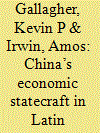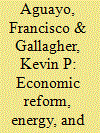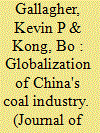|
|
|
Sort Order |
|
|
|
Items / Page
|
|
|
|
|
|
|
| Srl | Item |
| 1 |
ID:
136712


|
|
|
|
|
| Summary/Abstract |
Most scholars and policy-makers classify the motivation behind China’s global economic activity as an effort to project soft power or to exercise “extractive diplomacy” by locking up natural resources across the globe. In this paper we argue that China, through its state financial institutions and firms, is also significantly motivated by simply commercial reasons. To shed light on this debate, we examine the extent to which China’s policy banks provide finance to sovereign governments in Latin America. We find that Chinese policy banks now provide more finance to Latin American governments each year than do the World Bank and Inter-American Development Bank (IDB). Indeed, the large loan size, high interest rates and focus on industry and infrastructure of Chinese finance has less in common with these international financial issue_images_88_1_ChinaLatinAmerica01institutions (IFIs) and more in common with the private sovereign bond market. In this way, Chinese finance appears primarily commercial in nature. Chinese banks offer slightly lower interest rates than the private market, but these are not necessarily concessional subsidies to support a political agenda. The Chinese banks are exposed to less risk because they tie their loans to equipment purchase requirements and oil purchase contracts. Through these risk-lowering arrangements, Chinese banks can profit by lending to countries that have been priced out of the sovereign debt market. While it can be difficult to distinguish between the three types of economic statecraft outlined above, we argue that commercial profit is also a major force behind China’s economic statecraft that has been largely overlooked.
|
|
|
|
|
|
|
|
|
|
|
|
|
|
|
|
| 2 |
ID:
059756


|
|
|
| 3 |
ID:
135978


|
|
|
|
|
| Summary/Abstract |
We examine the extent to which Chinese development banks have financed the globalization of China's “national champion” firms: specifically, through outward foreign direct investment (OFDI). We create a database of Chinese finance for OFDI and compare our results to the existing literature and available data on Japan, Korea and other Asian nations. We estimate the total value of China's OFDI finance from 2002 to 2012 at US$140bn. As a percentage of total OFDI, China's lending is roughly three times higher than Japan's, the previous global leader in OFDI finance. We identify two major reasons for China's high (31 percent) ratio of OFDI lending to total OFDI. First, China has a greater incentive to give OFDI loans than Japan or Korea ever did because its borrowers are state-owned so it can more easily channel funds to targeted areas. Second, China has a greater capacity to give OFDI loans because it has significantly higher savings and foreign exchange reserves than Japan and Korea.
|
|
|
|
|
|
|
|
|
|
|
|
|
|
|
|
| 4 |
ID:
181839


|
|
|
|
|
| Summary/Abstract |
This article examines the political economy of Chinese overseas development finance for coal fired power plants. In just over a decade China's two major policy banks provide more financing for overseas coal-fired power plant expansion than any other public financier in the world economy. We show how China's overseas surge in public financing for coal fired power plants is a function of a number of domestic push and foreign pull factors. Excess capacity, environmental regulation, and structural change are push factors that converge with rising demand for energy, pockets of coal abundance, and the lack of financing in Western capital markets for coal fired power plants. Fragmentation across the Chinese system and the demand for coal outside China's borders allow for a decline sector on the mainland to become a global Chinese powerhouse.
|
|
|
|
|
|
|
|
|
|
|
|
|
|
|
|
| 5 |
ID:
156258


|
|
|
|
|
| Summary/Abstract |
This article explores the magnitude, motivations, and mechanisms of the globalization of Chinese finance for energy. Like the national development banks and export–import banks of industrialized countries before them, China’s policy banks have provided large amounts of financing to Chinese energy companies to enter global energy markets. What is more, China’s two global policy banks, the China Development Bank and the Export–Import Bank of China, now provide as much energy finance to foreign governments as do all the multilateral development banks combined. This paper outlines the extent to which Chinese energy finance has become globalized and examines the state priorities and institutional pathways that drive the globalization of Chinese energy finance.
|
|
|
|
|
|
|
|
|
|
|
|
|
|
|
|
| 6 |
ID:
180150


|
|
|
|
|
| Summary/Abstract |
This study aims to explain why China has become a new coal champion of the world. From 2006 to 2019, our new data set shows that China has financed 14 percent of the newly installed coal fired power plants across 17 countries around the world. We deploy a ‘push and pull’ analytical model and combine both qualitative and quantitative analysis to examine the political economy of Chinese overseas finance for coal. Our analysis shows that the globalization of Chinese official development finance for coal-fired power is a function of both the pull by the demand from the 17 countries, which have turned to the Chinese policy banks for financial backing to build coal-fired power plants, and the push by the coal-fired power equipment manufacturing sector in China and the central government in Beijing, which have been confronted with a set of structural challenges following the 2007–2008 global financial crisis. Our findings carry some worrisome policy implications for the global effort to reduce CO2 emissions resulting from coal burning in the electric sector. Without changes on the demand side, and a profound re-alignment of forces within China, Chinese development finance for coal-fired power may prove relatively resilient.
|
|
|
|
|
|
|
|
|
|
|
|
|
|
|
|
|
|
|
|
|